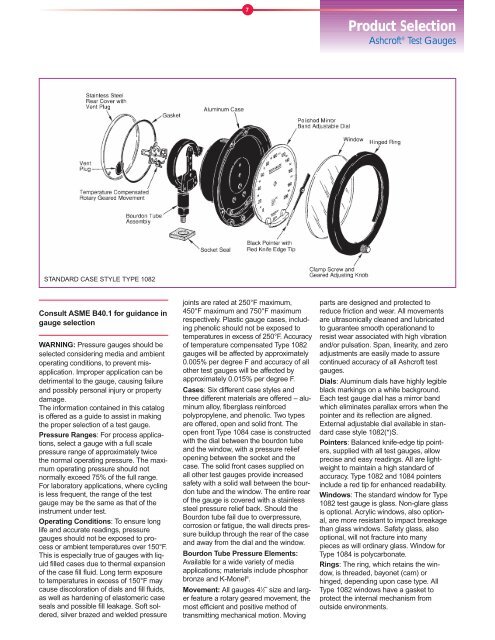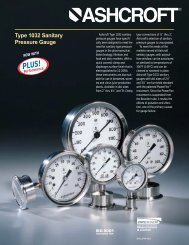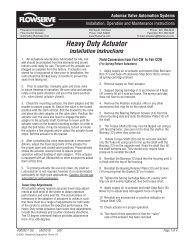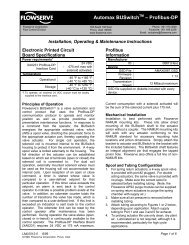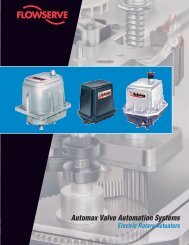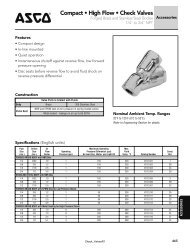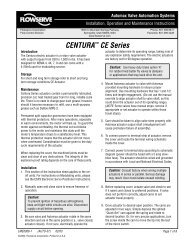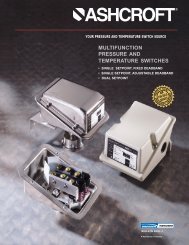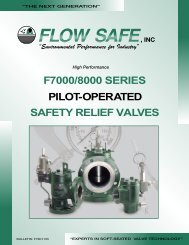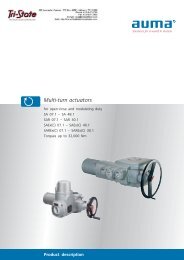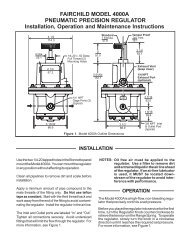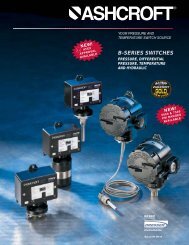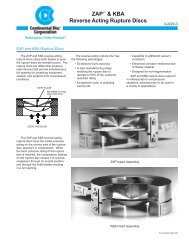Type 1082 and 1084 Test Gauge - Temp-Press Inc
Type 1082 and 1084 Test Gauge - Temp-Press Inc
Type 1082 and 1084 Test Gauge - Temp-Press Inc
Create successful ePaper yourself
Turn your PDF publications into a flip-book with our unique Google optimized e-Paper software.
7<br />
Product Selection<br />
Ashcroft ® <strong>Test</strong> <strong>Gauge</strong>s<br />
STANDARD CASE STYLE TYPE <strong>1082</strong><br />
Consult ASME B40.1 for guidance in<br />
gauge selection<br />
WARNING: <strong>Press</strong>ure gauges should be<br />
selected considering media <strong>and</strong> ambient<br />
operating conditions, to prevent misapplication.<br />
Improper application can be<br />
detrimental to the gauge, causing failure<br />
<strong>and</strong> possibly personal injury or property<br />
damage.<br />
The information contained in this catalog<br />
is offered as a guide to assist in making<br />
the proper selection of a test gauge.<br />
<strong>Press</strong>ure Ranges: For process applications,<br />
select a gauge with a full scale<br />
pressure range of approximately twice<br />
the normal operating pressure. The maximum<br />
operating pressure should not<br />
normally exceed 75% of the full range.<br />
For laboratory applications, where cycling<br />
is less frequent, the range of the test<br />
gauge may be the same as that of the<br />
instrument under test.<br />
Operating Conditions: To ensure long<br />
life <strong>and</strong> accurate readings, pressure<br />
gauges should not be exposed to process<br />
or ambient temperatures over 150°F.<br />
This is especially true of gauges with liquid<br />
filled cases due to thermal expansion<br />
of the case fill fluid. Long term exposure<br />
to temperatures in excess of 150°F may<br />
cause discoloration of dials <strong>and</strong> fill fluids,<br />
as well as hardening of elastomeric case<br />
seals <strong>and</strong> possible fill leakage. Soft soldered,<br />
silver brazed <strong>and</strong> welded pressure<br />
joints are rated at 250°F maximum,<br />
450°F maximum <strong>and</strong> 750°F maximum<br />
respectively. Plastic gauge cases, including<br />
phenolic should not be exposed to<br />
temperatures in excess of 250°F. Accuracy<br />
of temperature compensated <strong>Type</strong> <strong>1082</strong><br />
gauges will be affected by approximately<br />
0.005% per degree F <strong>and</strong> accuracy of all<br />
other test gauges will be affected by<br />
approximately 0.015% per degree F.<br />
Cases: Six different case styles <strong>and</strong><br />
three different materials are offered – aluminum<br />
alloy, fiberglass reinforced<br />
polypropylene, <strong>and</strong> phenolic. Two types<br />
are offered, open <strong>and</strong> solid front. The<br />
open front <strong>Type</strong> <strong>1084</strong> case is constructed<br />
with the dial between the bourdon tube<br />
<strong>and</strong> the window, with a pressure relief<br />
opening between the socket <strong>and</strong> the<br />
case. The solid front cases supplied on<br />
all other test gauges provide increased<br />
safety with a solid wall between the bourdon<br />
tube <strong>and</strong> the window. The entire rear<br />
of the gauge is covered with a stainless<br />
steel pressure relief back. Should the<br />
Bourdon tube fail due to overpressure,<br />
corrosion or fatigue, the wall directs pressure<br />
buildup through the rear of the case<br />
<strong>and</strong> away from the dial <strong>and</strong> the window.<br />
Bourdon Tube <strong>Press</strong>ure Elements:<br />
Available for a wide variety of media<br />
applications; materials include phosphor<br />
bronze <strong>and</strong> K-Monel ® .<br />
Movement: All gauges 4 1 ⁄2˝ size <strong>and</strong> larger<br />
feature a rotary geared movement, the<br />
most efficient <strong>and</strong> positive method of<br />
transmitting mechanical motion. Moving<br />
parts are designed <strong>and</strong> protected to<br />
reduce friction <strong>and</strong> wear. All movements<br />
are ultrasonically cleaned <strong>and</strong> lubricated<br />
to guarantee smooth operation<strong>and</strong> to<br />
resist wear associated with high vibration<br />
<strong>and</strong>/or pulsation. Span, linearity, <strong>and</strong> zero<br />
adjustments are easily made to assure<br />
continued accuracy of all Ashcroft test<br />
gauges.<br />
Dials: Aluminum dials have highly legible<br />
black markings on a white background.<br />
Each test gauge dial has a mirror b<strong>and</strong><br />
which eliminates parallax errors when the<br />
pointer <strong>and</strong> its reflection are aligned.<br />
External adjustable dial available in st<strong>and</strong>ard<br />
case style <strong>1082</strong>(*)S.<br />
Pointers: Balanced knife-edge tip pointers,<br />
supplied with all test gauges, allow<br />
precise <strong>and</strong> easy readings. All are lightweight<br />
to maintain a high st<strong>and</strong>ard of<br />
accuracy. <strong>Type</strong> <strong>1082</strong> <strong>and</strong> <strong>1084</strong> pointers<br />
include a red tip for enhanced readability.<br />
Windows: The st<strong>and</strong>ard window for <strong>Type</strong><br />
<strong>1082</strong> test gauge is glass. Non-glare glass<br />
is optional. Acrylic windows, also optional,<br />
are more resistant to impact breakage<br />
than glass windows. Safety glass, also<br />
optional, will not fracture into many<br />
pieces as will ordinary glass. Window for<br />
<strong>Type</strong> <strong>1084</strong> is polycarbonate.<br />
Rings: The ring, which retains the window,<br />
is threaded, bayonet (cam) or<br />
hinged, depending upon case type. All<br />
<strong>Type</strong> <strong>1082</strong> windows have a gasket to<br />
protect the internal mechanism from<br />
outside environments.


